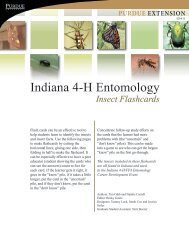Pink Gypsy Moth - aphis - US Department of Agriculture
Pink Gypsy Moth - aphis - US Department of Agriculture
Pink Gypsy Moth - aphis - US Department of Agriculture
You also want an ePaper? Increase the reach of your titles
YUMPU automatically turns print PDFs into web optimized ePapers that Google loves.
status <strong>of</strong> many plants is largely inferred from the genera <strong>of</strong> plants attacked in<br />
Asia. Additional research is needed to confirm the susceptibility <strong>of</strong> <strong>US</strong> species.<br />
If host associations at the genus level continue to hold, several plants in the <strong>US</strong><br />
would be threatened. Many <strong>of</strong> these hosts naturally occur over broad geographic<br />
areas and in relatively high densities. Thus, the potential for establishment seems<br />
high, but our confidence in this assessment is, at best, moderate.<br />
See Appendix E for a more detailed description <strong>of</strong> the biology <strong>of</strong> L. mathura.<br />
References<br />
Anon. 2001. Russian Lymantria Project. <strong>US</strong>FS Forest Health Protection Intermountain<br />
Region. Available on-line at http://www.fs.fed.us/r1-<br />
r4/spf/fhp/publications/weis_final.htm. Accessed 22 August 2005.<br />
Armstrong, K. F., P. McHugh, W. Chinn, and F. E.R. 2003. Tussock moth species<br />
arriving on imported used vehicles determined by DNA analysis. New Zealand<br />
Plant Protection 56: 16-20.<br />
Baranchikov, Y., T. Vshivkova, and M. Montgomery. 1995. Suitability <strong>of</strong> foreign tree<br />
species for Lymantria mathura Moore. pp. 49. In S. L. C. Fosbroke and K. W.<br />
Gottschalk [eds.]. Proceedings, U.S. <strong>Department</strong> <strong>of</strong> <strong>Agriculture</strong> Interagency<br />
<strong>Gypsy</strong> <strong>Moth</strong> Research Forum, 17-20 January, 1995, Annapolis, Maryland. <strong>US</strong>DA<br />
Forest Service General Technical Report NE-213.<br />
Beeson, C. F. C. 1941. The ecology and control <strong>of</strong> the forest insects <strong>of</strong> India and the<br />
neighboring countries. Vasant Press, Dehro Dun.<br />
Boulton, T. J. 2004. Responses <strong>of</strong> nontarget Lepidoptera to Foray 48 B® Bacillus<br />
thuringiensis var. kurstaki on Vancouver Island, British Columbia. Environmental<br />
Toxicology and Chemistry 23: 1297-1304.<br />
Browne, F. G. 1968. Pests and diseases <strong>of</strong> forest plantation trees. Clarendon Press,<br />
Oxford.<br />
CAB. 2004. Crop Protection Compendium. CAB International. Available on-line at<br />
http://www.cabicompendium.org/cpc. Accessed 5 July 2005.<br />
EPPO. 2005. Data sheets on quarantine pests: Lymantria mathura. European and<br />
Mediterranean Plant Protection Organization. Available on-line at<br />
http://www.eppo.org/QUARANTINE/insects/Lymantria_mathura/DSLYMAMA.<br />
pdf. Accessed 29 September 2005.<br />
Funakoshi, S. 2004. Larvae <strong>of</strong> three Lymantria species found on Quercus glauca,<br />
including L. minomonis Matsumura (Lymantriidae). The Japan Heterocerist's<br />
Journal 231: 107-108.<br />
Gninenko, Y. I., and M. Y. Gninenko. 2002. Little known lymantriids <strong>of</strong> the Russian<br />
Far East - potential for movement to other countries <strong>of</strong> the Pacific region. Bulletin<br />
OEPP/EPPO Bulletin 32: 477-480.<br />
Gries, G., R. Gries, P. W. Schaefer, T. Gotoh, and Y. Higashiura. 1999. Sex<br />
pheromone components <strong>of</strong> pink gypsy moth, Lymantria mathura.<br />
Naturwissenschaften 86: 235-238.<br />
Hoddle, M. S., and P. Syrett. 2002. Realizing the Potential <strong>of</strong> Classical Biological<br />
Control, pp. 395-424. In G. J. Hallman and C. P. Schwalbe [eds.], Invasive<br />
CAPS PRA: Lymantria mathura 11
















